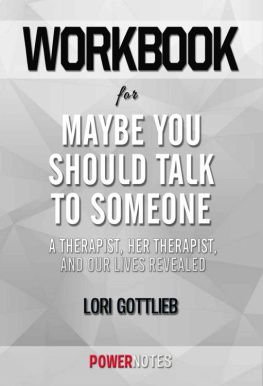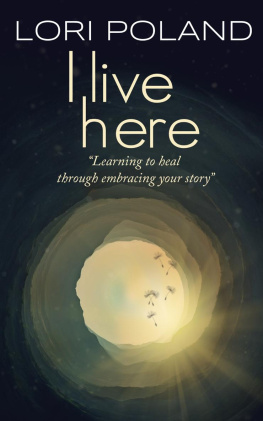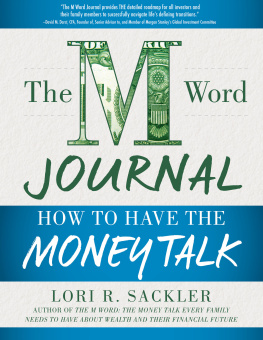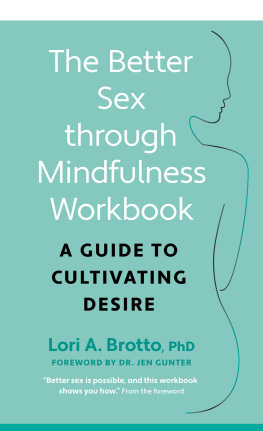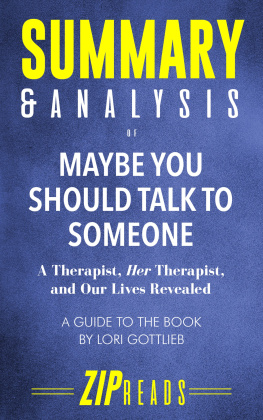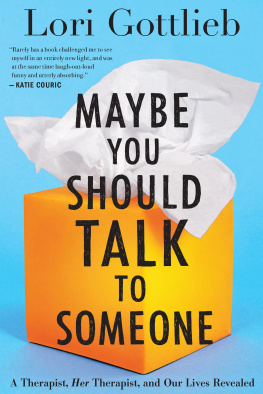Workbook
Maybe You Should Talk to Someone: A Therapist, HER Therapist, and Our Lives Revealed
Lori Gottlieb, Brittany Pressley
Fun Facts For Fans
PowerNotes
A delightfully informative read dedicated to readers.
Copyright 2022 by PowerNotes . All Rights Reserved.
No part of this publication may be reproduced or retransmitted, electronic or mechanical, without the written permission of the publisher.
Disclaimer: Although the Author and Publisher made all attempts to verify information, they do not assume any responsibility for errors, omissions, or contrary interpretation of the subject matter contained within as perceived slights of peoples, persons, organizations are unintentional and information contained within should not be used as a source of legal, business, accounting, financial, or other professional advice. This is an unofficial workbook for analytical review and educational purposes only and has not been authorized, affiliated, or endorsed by the original book author or publisher and any of their licensees or affiliates. If you have not yet purchased the original work, we encourage you to do so prior to the purchase of this unofficial workbook.
Bonus Gift: Get Your FREE Download Below
Claim Your Bestselling Titles Now

As a Thank You for Purchasing PowerNotes , weve included
a completely FREE gift of All-Time Top Bestselling Kindle PowerNotes to our readers FREE.
Get My Bestselling Titles Free
Tap the Link Above to Download

Open 'Camera on Your Smartphone to Scan QR code
CONTENTS

Part One: Facts & Tidbits
About the Success & Uniqueness of the Book

- Maybe You Should Talk to Someone is a memoir about Gottlieb's personal and professional struggles. The book's dual nature allows Gottlieb to depict her reality as both a therapist and a patient. In it, she also analyzes five patients' experiences and perspectives on life.
- Maybe You Should Talk to Someone is a memoir and a form of therapy in one. This book distills the author's own views, details her clinical observations, and is full of psychology tidbits. Gottlieb invites you not just inside her mind as a therapist but also into her heart.
- Gottlieb's devotion to helping her patients heal and grow is unlike any other. What therapists will see in the book is another clinician's skillful use of her knowledge to provide effective therapy. But for the ordinary reader, there's a lot to learn about psychological change, loss and melancholy, purpose in life and work, pain and suffering, and forming personal connections.
- Gottlieb explores the concepts of belonging, emotional agony, and healing while establishing an intimate relationship between patient and therapist via psychological suffering. As a mid-40s single mother, and as a smart, often hilarious psychotherapist, Gottlieb's experiences will resonate with readers. The book's eavesdropping on Gottlieb's therapy sessions with fascinating individuals in various levels of distress is both interesting and voyeuristic.
- One strand of this narrative is a conundrum: Gottlieb's long-term boyfriend broke up with her because he doesn't want to father her child. As a result of her boyfriend's abrupt departure and betrayal, Gottlieb seeks therapy to determine her next steps. We see her first as a person, then as a therapist, as we learn more about her personal and professional history.
- The book's second strand feels like a group therapy session. Gottlieb welcomes us in behind closed doors and allows us to meet a handful of her patients. Through their conversations, we see genuineness, boldness, care, sensitivity, closeness, and depth of feeling amidst chaos.
- Gottlieb's narrative explores what it's like for therapists to seek and accept treatment. Readers may sense what patients feel in therapy via Gottlieb's slow-cooker connection with her weirdly intriguing therapist, Wendell Bronson. Even experienced therapists may cringe at Gottlieb's inquiries.
- Gottlieb utilizes the concept of vulnerability to show how openness to others is essential to progress. Her patients sessions are a testament to this idea. We get to know them via their own confessions, dreams, anecdotes, and experiences. Similarly, she isn't scared to talk about herself.
- The entirety of Maybe You Should Talk to Someone is based on change. It reflects Gottlieb's personal transformations in treatment. It also tracks her patients' progress in therapy.
- The book alternates between Gottlieb's prior recollections and her present as a psychotherapist. While the story is typically chronological, she may sometimes bring up memories with her patients for context. Each chapter begins with a "chart note" that introduces the patient and their psychological difficulties.
- Gottlieb's therapy room plays a significant part in the book. There, she is able to meet face-to-face with her patients and get a deeper understanding of their experiences. It's a safe, welcoming environment.
- Some of Gottlieb's patients are sympathetic. Others are tougher to like. A comment by the author emphasizes that the patients' lives have been anonymized, making their stories a vessel of experience for the readers.
- A recently married cancer patient's despair, a divorced woman's severe ultimatum for her future, and women locked in a cycle of unregulated drinking or toxic relationships are among the tragic portraits painted by Gottlieb in her book. These events allow her to reflect and self-analyze. She also reveals how patients see their therapists and the unwritten norms psychotherapists must follow.
- Maybe You Should Talk to Someone offers psychotherapy as a creative process. On Gottlieb's road to acceptance, she stumbles through heartache, self-sabotage, evasion, and denial. She narrates these experiences with candor and humor, without hiding her flaws.
- Maybe You Should Talk to Someone is a New York Times bestseller and Time magazine's Must-Read Book of the Year. It was nominated for a Nonfiction Goodreads Choice Award. In addition, The Oprah Magazine named it the year's best nonfiction.
Part Two: Facts & Tidbits

